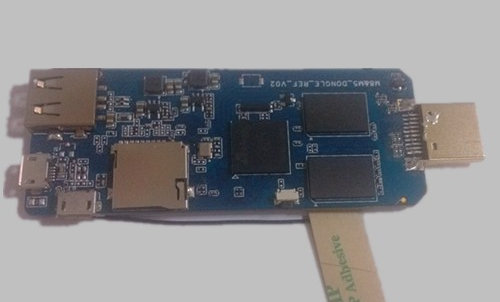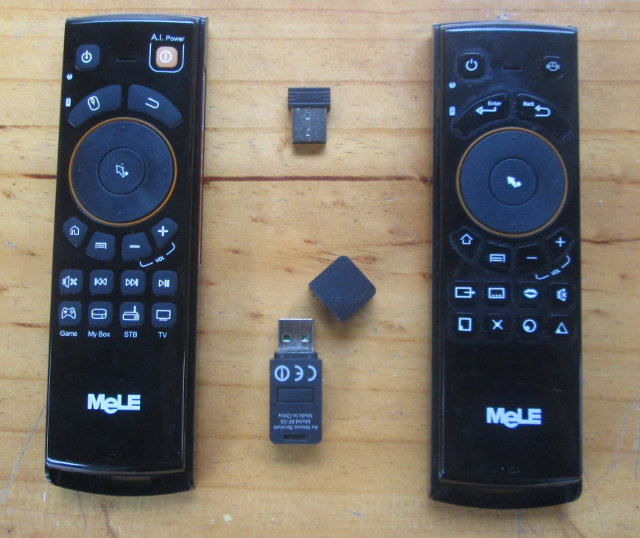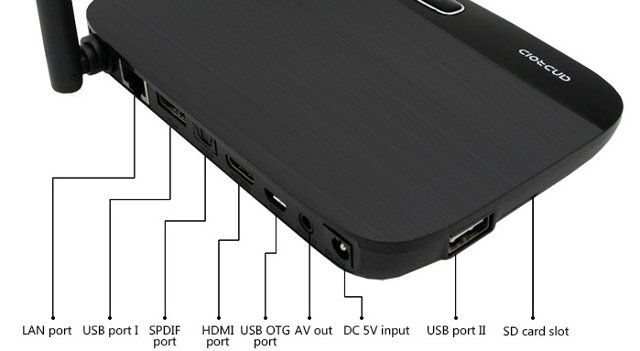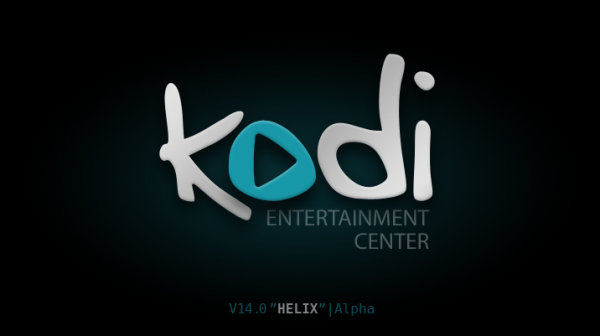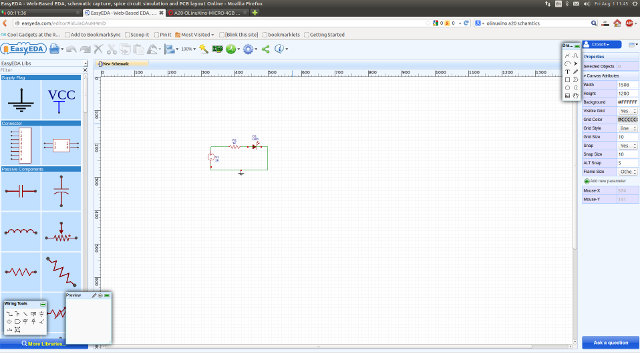Software-Defined Radios (SDR) are neat little devices that capture radio signals which are then filtered and decoded by software on your PC or embedded system. The currently used radio spectrum is extremely wide from 3 to 30Hz for submarine communication up to 30 to 300+ GHz or more for applications such as amateur radio or radio astronomy. So the price of hardware needed for SDRs varies greatly depending on the frequency range supported, bandwidth, and other technical parameters. Hobbyists can use “low cost” ($300 – $400) FPGA SDR boards such as bladeRF or HackRF, or go ultra-cheap with $20+ RTL-SDR USB TV tuners. I’ve been informed there’s a development kit sold under the name “100KHz-1.7GHz Full Band UV HF RTL-SDR USB Tuner Receiver DIY Kit” based on the latter, but with extra components, on various sites such as Buyincoins, Ebay, Aliexpress, etc.. for just $33 to $45. The problem with […]
Ugoos S85 Android HDMI TV Stick Features Amlogic S805 Quad Core SoC, Supports H.265 Video Decoding
HDMI TV sticks used to be popular, but as processors became more powerful, it became more and more challenging to put new SoCs in such a small form factor due to thermal issues. For example, there’s no HDMI TV stick powered by Amlogic S802 (4x Cortex A9 @ 2GHz), as even TV boxes may have troubles keeping things cool with two largish heatsinks. But the new Amlogic S805 quad core ARM Cortex A5 is more power-efficient, and Ugoos will soon release S85 model in an HDMI stick form factor. For now, they’ve just published some pictures of the board. Ugoos S85 specifications: SoC – Amlogic S805 Quad-Core Cortex-A5 @ 1.5GHz with Quad Core ARM Mali-450MP GPU @ 600MHz System Memory – 1GB DDR3 Storage – 8GB NAND FLASH + micro SD card slot Video & Audio Output – HDMI 1.4b with CEC (male connector) Video Codecs – MPEG1/2/4, H.265, HD […]
Some Projects on Nvidia Jetson TK1 Development Board: Nintendo Emulator, USB3 Webcam, and Robotics
Nvidia Jetson TK1 is a development board powered by the company’s Tegra K1 quado core Cortex A15 processor, and especially a Kepler GPU that allows for OpenGL 4.4. It has shipped to developers around April/May, and some of them have showcased their projects, or tested some hardware. Dolphin Emulator on Nvidia Jetson TK1 Dolphin is an emulator for Nintendo GameCube and Wii console that supports full HD (1080p) rendering, and run on Android, Linux and Mac OS, and there’s also an Alpha version for Android. Ryan Houdek (Sonicadvance1), one of Dolphin’s developers, has leveraged Kepler’s OpenGL support via Nvidia’s GPU drivers, to port the emulator to the platform running on Ubuntu, but it should work as well on Tegra K1 hardware running Android such as XiaoMi MiiPad tablet. You can watch Mario Kart: Double Dash demo running at full speed on the Nvidia board below. According to the developer, such […]
Mele F10 Deluxe Air Mouse Review
Mele F10 is an air mouse using 2.4GHz RF technology, that can be used as a remote, a QWERTY keyboard, and a wireless mouse. That’s my favorite input device for Android TV Box, and I use it regularly for my product reviews. The company has now introduced an improved model called Mele F10 Deluxe with trick mode buttons, a gaming mode thanks to a gyroscope, and an IR learning function to use it as a universal remote. Mele sent me a sample for evaluation, so I’ll start with some unboxing pictures, and compare it to the original Mele F10, before testing the remote. Mele F10 Deluxe Unboxing I’ve received the air mouse in the package below that highlights the four main features: Air mouse, Game Controller, Wireless Keyboard, and IR Learning. We’ll find the air mouse, a tiny RF dongle, a USB cable for charging, and a user’s manual describing […]
Dual Core VolksPC Android and Debian Mini PC Gets Crowdfunded
Last months, I tested VolksPC’s Android/Debian unified distribution on MK808 mini PC, which runs both operating systems at the same time, and allows you to switch instantaneously and seamlessly between the two. I was impressed by the performance and stability of the system, although there were still a few software bugs, as well as issues related to MK808 hardware (Wi-Fi disconnection), and possibly its 5V/1A power supply (system reboot when inserting SD card reader or flash drive). The company has now started a crowd-funding campaign on Indiegogo to manufacture dual core Android TV box with their unified distribution. VolksPC specifications: SoC – Rockchip RK3066 dual core ARM Cortex-A9 processor @ 1.4Ghz with Mali-400MP4 GPU System Memory – 1GB DDR3 Storage – 8 GB NAND Flash (for Android), 8GB MicroSD card (Debian Wheezy) Video Output – HDMI 1.3, AV jack Audio Output, HDMI, AV jack, and optical S/PDIF Connectivity – 10/100M […]
XBMC is Dead, Long Live Kodi Entertainment Center!
Don’t worry, the XBMC project that many people use and love is not really dead, but it won’t be called XBMC anymore. Developers have chosen to go with “Kodi Entertainment Center”, starting with version 14, which will be called Kodi 14, and not XBMC 14. Nothing else changes from the user’s perspective, and the code will still be licenses under GPL 2.0, but the name Kodi is now trademarked, and it may affect how websites and hardware vendors use Kodi name and logo. There are several reasons behind the name change, the fourth for the project. Initially it was called Xbox Media Player, then changed to Xbox Media Center as it could do more than just a media player, and finally the name was shortened to XBMC because it could run on various hardware, and not only Xbox. Forward to 2014, XBMC is barely supported on Xbox, and does not […]
EasyEDA is a Web-based Schematics Capture, Simulation, and PCB Layout Tool
I recently watched a video showing AllWinner R&D, and I noticed although most (all?) software engineer run Ubuntu in the PC, the hardware engineers all relied on Windows based EDA tools for schematics capture and PCB Layout. There are already Linux-based tools such as Kicad, which appears to be good for new projects, but importing existing projects can be an issue. An alternative to operating system dependent EDA software suites are web-based tools. I’ve already tried Fritzing which allows to draw circuits on breadboard, convert these to schematics and PCB layouts, and order the PCBs. It looks pretty good for its purpose, but it’s limited to mostly simple designs, and AFAIK can’t be used to replace an EDA suite. That’s where EasyEDA comes into play. It’s a web-based tool where you can draw schematics, perform simulation, and create PCB layouts for your project, either keeping them private, or sharing them […]
Linaro 14.07 Release with Linux Kernel 3.16 and Android 4.4
Linaro 14.07 has just been released with Linux Kernel 3.16-rc6 (baseline), Linux Kernel 3.10.50 (LSK), and Android 4.4.4. This month, Linaro has continued development on Juno 64-bit ARM development board, as well as other member boards from Broadcom (Capri), Qualcomm (IFC6410), Hisilicon D01, Samsung (Arndale / Arndale Octa), etc.. Android have been upgraded to version 4.4.4 with images released for Pandaboard, Arndale, Nexus 10, and Nexus 7, built with Linaro GCC 4.9. Here are the highlights of this release: Linux Linaro 3.16-rc6-2014.07 released GATOR version 5.18 (same version as in 2014.04) updated basic Capri board support from Broadcom LT. Good progress in upstreaming the code: now the topic has 21 patch on top of v3.16-rc4 vs 53 patches on top of v3.15 in 2014.06 cycle removed cortex-strings-arm64 topic as the code is accepted into the mainline new topic from Qualcomm LT to add IFC6410 board support updated Versatile Express ARM64 […]



